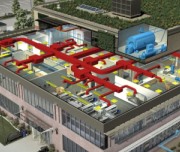System Impacts
| Human Behavior on System | System Impact on Humans |
|---|
Human Behavior on System
People’s behavior is a critical factor in a building’s energy use and can often account for significant changes in the amount of energy consumed. Plug and process loads alone account for 33% of an office building’s energy consumption and is projected to increase 49% by 20301. As our daily work and lives continue to use more energy consuming devices, building occupants and building systems need to operate together to improve energy efficiency.
Occupant Behavior on Submetering System Benefits
Leading practices show that increasing occupant awareness of usage, coupled with an effective conservation campaign can reduce resource consumption and improve occupant engagement. Providing building occupants with knowledge of their energy use, as well as easy and helpful tips for helping them reduce their consumption could provide significant reductions in a building’s overall energy use. Quick tips and easy to make changes such as turning off computers and other ancillary devices at the end of the day can account for real energy savings.
Submeters can collect occupant energy use and provide individuals with data that can be used help monitor behavior in a transparent way. Energy display dashboards, monthly reports and fliers, emails, and web-based portals, are methods that can be used to provide building occupants with access to their individual energy use. The example energy dashboards pictured below provide users with a summary of their energy trends and overall use. Dashboards can be used by individuals to help identify ways to reduce consumption by visualizing the near real-time effects of energy behavior changes.

Sample dashboards from the GSA Carbon Footprint Tool.
By delivering real-time energy information in a convenient way, users can learn to act more efficiently by making easy and important changes to their everyday behavior. Consequently, occupant behavior changes can lead to larger-scale building conservation outcomes and results.
Find more about plug loads and management strategies here.
Best Practices and Strategies
| Consider investing in public-facing dashboards and monitors to display submetering information for building occupants. | Consider working and collaborating with agency or organizational CIO to prepare for communications, networking and mapping impacts for data integration. | Review that meter installation is in accordance with tenant lease and billing procedures. “Green Leases” ability to pass on cost of energy improvements to tenants requires that the submetering program meet existing lease requirements. |
| Consider leveraging submetering information to provide accountability and incentives for building operations teams through score cards or performance benchmarking. | Place an emphasis on plug and process loads as they are one of the fastest-growing sources of energy consumption in buildings. | Simplify real-time and interval data collected by submeters in an energy metering system that organizes building resource use according to energy and emission reduction goals. |
| Educate occupants about turning off lights and computers before leaving the building. |

